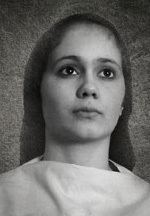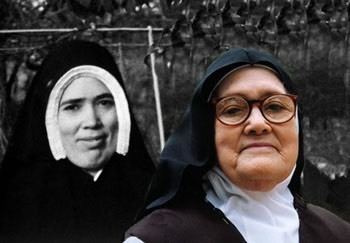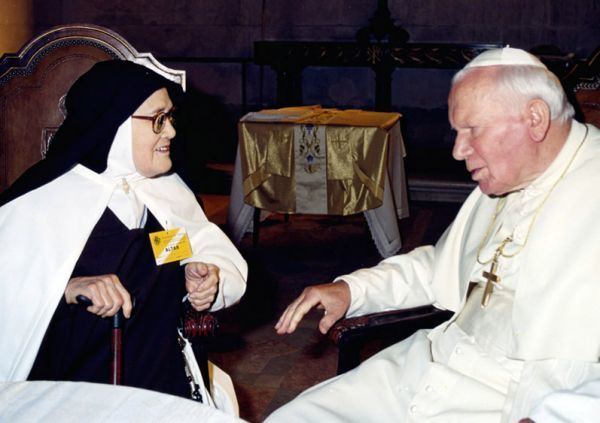Nationality Portuguese Role Nun | Name Lucia Santos | |
 | ||
Born 28 March 1907 (age 97), Aljustrel, FatimaKingdom of Portugal Other names Sister Mary Lucy of Jesus and of the Immaculate Heart Occupation Roman Catholic Discalced Carmelite nun Known for Visionary to the Marian apparitions at Fatima Siblings Maria Rosa, Maria dos Anjos, Manuel Rosa Santos Books Fatima in Lucia\'s Own Words, Apelos da Mensagem de Fatima Parents Maria Rosa Santos, Antonio Santos Similar Bernadette Soubirous, Jacinta and Francisco Marto, Pope John Paul II Died 13 February 2005 (aged 97) Coimbra, Portugal | ||
Unseen Pictures of Sister Lucia!
Sister Lucia (2/13/16)
Lúcia de Jesus dos Santos, O.C.D. (March 28, 1907 – February 13, 2005), also known as Lúcia of Fátima and by her religious name Sister Maria Lúcia of Jesus and the Immaculate Heart, was a Portuguese Catholic Carmelite nun and one of the three children to witness the 1917 Marian apparitions in Fátima.
Contents
- Unseen Pictures of Sister Lucia
- Sister Lucia 21316
- Early life
- Apparitions of Our Lady of Ftima
- The Three Secrets
- Miracle of the Sun
- Life in the convent
- Writings
- Death
- Beatification process
- Conspiracy theory
- References

Early life

Lúcia was the youngest child of António dos Santos and Maria Rosa Ferreira (1869-1942), both from Aljustrel, who married on 19 November 1890. She had six brothers and sisters: Maria dos Anjos (1891-1986), Teresa de Jesus Rosa dos Santos, Manuel Rosa dos Santos (1895-1977), Glória de Jesus Rosa dos Santos (1898-1971), Carolina de Jesus Rosa dos Santos (1902-1992), Maria Rosa (died at birth). Although peasants, the Santos family was by no means poor, owning land "in the direction of Montelo, Our Lady of Ortiga, Fátima, Valinhos, Cabeço, Charneca, and Cova da Iria."
Even though Lúcia's birthday is registered as March 22, 1907, her actual date of birth is March 28. In those days it was required that parents bring their children for baptism on the eighth day after birth or face a fine, and, because March 30 was a more convenient day, the 22nd was chosen as her birthday. Lúcia later recalled that, at the time, no one attached much importance to one's birthday.

Lúcia's father António, by her report, was a hardworking and generous man. Lúcia remembered him telling fairy tales and singing folk songs, but he was also the one who first taught her to make the Sign of the Cross. Contrary to popular hagiographical accounts of the apparitions, he believed the children and there is some evidence that he conspired to make sure Lúcia got to the Cova for the visitations after her mother had forbidden it. Lúcia said that her father was not a particularly heavy drinker, but liked to socialize in the tavern. Because he did not like Fr. Ferreira, he went to church in a nearby town.

Maria Rosa was literate, although she never taught her children to read. She had a taste for religious literature and storytelling. She gave catechism lessons to her children and the neighbor's children, if they were there, at siesta time during the summer and especially around Lent. During the winter, catechism lessons took place after supper and around the fire. According to her mother, Lúcia repeated everything that she heard "like a parrot."

Fr. De Marchi described her features in the following manner: "She was not a pretty child. The only attractions of her face — which was not on the whole repellent — were her two great black eyes which gazed out from under thick eyebrows. Her hair, thick and dark, was parted in the center over her shoulders. Her nose was rather flat, her lips thick and her mouth large."
Lúcia was a fabulous storyteller with a "gift for narration." She had a talent for composing original songs, with catchy folk-style tunes and sacred and secular lyrics. Among the songs she invented as a small child are "In Heaven, I'll Be With My Mother", "I Love God in Heaven", and "Lady of Carmel". She set to music the words of the brief prayer she said had been taught to her and her cousins by an angel; "O God, I believe, I adore..." She also wrote a poem about Jacinta which appears in her memoirs.
Lúcia's First Communion occurred at six years of age despite ten being the usual minimum. Initially, the parish priest refused because of her young age. However, Fr. Cruz, a Jesuit missionary visiting from Lisbon, interviewed Lúcia after finding her in tears that day and concluded that "she understands what she's doing better than many of the others." Because of this intervention, the parish priest admitted Lúcia to Holy Communion. After her First Confession she prayed before the altar of Our Lady of the Rosary and saw the statue smile at her. Upon receiving the Eucharist, Lúcia felt "bathed in such a supernatural atmosphere that the presence of our dear Lord became as clearly perceptible to me as if I had seen and heard Him with my bodily senses." Lúcia's First Communion left a deep impact on her. "I lost the taste and attraction for the things of the world, and only felt at home in some solitary place where, all alone, I could recall the delights of my First Communion."
By eight years of age she was tending the family's sheep, accompanied by other boys and girls of the village.
Apparitions of Our Lady of Fátima
Between May and October 1917, Lúcia and her cousins Jacinta and Francisco Marto reported visions of a luminous lady, who they believed to be the Virgin Mary, in the Cova da Iria fields outside the hamlet of Aljustrel, near Fátima, Portugal. The children said the visitations took place on the 13th day of each month at approximately noon, for six straight months. The only exception was August, when the children were detained by the local administrator. That month they did not report a vision of the Lady until after they were released from jail, two days later.
According to Lúcia's accounts, the lady told the children to do penance and to make sacrifices to save sinners. Lúcia said that the lady stressed the importance of saying the Rosary every day, to bring peace to the world. Many young Portuguese men, including relatives of the visionaries, were then fighting in World War I. Lúcia heard Mary ask her to learn to read and write because Jesus wanted to employ her to convey messages to the world about Mary, particularly the Immaculate Heart of Mary.
Lúcia's mother did not take kindly to the news that her youngest daughter was having visitations, believing that Lúcia was simply making up lies for attention. Heretofore the favorite, Lúcia suffered beatings and ridicule from her mother. She was especially incredulous of the idea that Lúcia had been asked to learn to read and write.
The Three Secrets
On July 13, 1917, around noon, the lady is said to have entrusted the children with three secrets. Two of the secrets were revealed in 1941 in a document written by Lúcia, at the request of the Bishop of Leiria, José Alves Correia da Silva, partly to assist with the publication of a new edition of a book on Jacinta.
On January 25, 1938, a massive aurora borealis, described variously as "a curtain of fire" and a "huge blood-red beam of light," appeared in the skies over Europe and was visible as far away as Gibraltar and even parts of the United States. Lúcia believed this event was the "night illuminated by a strange light in the sky" which she had heard Mary speak about as part of the Second Secret, predicting the events which would lead to the Second World War and requesting Acts of Reparation including the First Saturday Devotions, along with the Consecration of Russia.
When asked by José Alves Correia da Silva, Bishop of Leiria in 1943 to reveal the third secret, Lúcia struggled for a short period, being "not yet convinced that God had clearly authorized her to act." She was under strict obedience in accordance with her Carmelite life, and conflicted as to whether she should obey her superiors, or the personal orders she had heard from Mary. However, in October 1943 she fell ill with influenza and pleurisy, the same illness which had killed her cousins, and for a time believed she was about to die. Bishop Da Silva then ordered her to put the third secret in writing. Lúcia then wrote down the secret and sealed it in an envelope not to be opened until 1960. She designated 1960 because she thought that "by then it will appear clearer." The text of the third secret was officially released by Pope John Paul II in 2000. The Vatican described the secret as a vision of the 1981 assassination attempt on Pope John Paul II.
Miracle of the Sun
The visions increasingly received wide publicity, and an estimated seventy thousand witnesses were reportedly present for the sixth and final apparition. Lúcia had promised for several months that the lady would perform a miracle on that day "so that all may believe." Witnesses present in the Cova da Iria that day, as well as some up to 25 miles (40 km) away, reported that the sun appeared to change colors and rotate, like a fire wheel, casting off multicolored light across the landscape. The sun appeared to plunge towards the earth, frightening many into believing that it was the end of the world. Others suggested they had merely witnessed an eclipse. The popular expression, according to the O Século reporter Avelino de Almeida, was that the sun "danced." The event became known as the Miracle of the Sun. The episode was widely reported by the Portuguese secular media. Some coverage appeared in a small article in the New York Times on October 17, 1917. Lúcia reported that day that the Lady identified herself as "Our Lady of the Rosary." She thereafter also became known as Our Lady of Fátima.
On behalf of the Catholic Church, Bishop Da Silva, approved the visions as "worthy of belief" on October 13, 1930.
Life in the convent
Lúcia moved to Porto in 1921, and at 14 was admitted as a boarder in the school of the Sisters of St. Dorothy in Vilar, on the city's outskirts. On October 24, 1925, she entered the Institute of the Sisters of St. Dorothy as a postulant in the convent in Tui, Spain, just across the northern Portuguese border. Lúcia professed her first vows on October 3, 1928, and her perpetual vows on October 3, 1934, receiving the name "Sister María das Dores" (Mary of the Sorrows).
She returned to Portugal in 1946 (where she visited Fátima incognito) and in March 1948, after receiving special papal permission to be relieved of her perpetual vows, entered the Carmelite convent of Santa Teresa in Coimbra, where she resided until her death. She made her profession as a Discalced Carmelite on May 31, 1949, taking the religious name Sister Maria Lúcia of Jesus and the Immaculate Heart.
Because of the Constitutions of the community, Lúcia was expected to "converse as little as possible with persons from without, even with their nearest relatives, unless their conversation be spiritual, and even then it should be very seldom and as brief as possible" and "have nothing to do with worldly affairs, nor speak of them...". This has led some people, such as Fr. Gruner of the Fátima Crusaders, to believe in a conspiracy to cover up the Fátima message and silence Lúcia.
She came back to Fátima on the occasion of four papal pilgrimages—all on May 13—firstly by Paul VI in 1967, and John Paul II in 1982 (in thanksgiving for surviving an assassination attempt the previous year), 1991, and 2000, when her cousins Jacinta and Francisco were beatified. On May 16, 2000, she unexpectedly returned to Fátima to visit the parish church.
Writings
Lúcia wrote six memoirs during her lifetime. The first four were written between 1935 and 1941, and the English translation is published under the name Fatima in Lucia's Own Words. The fifth and six memoirs, written in 1989 and 1993, are published in English under the name Fatima in Lucia's Own Words II. These latter books were written in her own handwriting.
An additional book was published in 2001, variously known as Calls from the Message of Fatima and Appeals of the Fatima Message, as announced by the Vatican on December 5, 2001.
Lúcia also wrote numerous letters to clergy and devout laypeople who were curious about the Third Secret of Fátima and about Lúcia's interpretation of what she had heard Mary request. Two letters she wrote concerned the Consecration of Russia, in which she said Our Lady's request had been fulfilled.
Death
Sister Lúcia had been blind and deaf and ailing for some years prior to her death. She died at the Carmelite convent of Santa Teresa in Coimbra, where she had lived since 1948. The day of her funeral, Pope John Paul II and the future Pope Benedict XVI said that she would go to Heaven. February 15, 2005, was declared a day of national mourning in Portugal; even campaigning for the national parliamentary election scheduled for Sunday, February 20, was interrupted. Sister Lúcia was a registered voter, and her polling place visits were covered by the Portuguese press.
Beatification process
On February 13, 2008 (the third anniversary of her death) Pope Benedict XVI announced that in the case of Sister Lúcia he would waive the five-year waiting period established by ecclesiastical law before opening a cause for beatification; this rule was also dispensed in the causes for Mother Teresa of Calcutta and Pope John Paul II.
Conspiracy theory
There are rumours that Sister Lúcia was later replaced by an impostor, with the supposed idea that the replacement would urge the Church not to reveal the Third Secret in 1960. Another that she was forced to confirm that the Third Secret was about Pope John Paul II being shot (some believe this is not what the Secret is about). A documentary research investigation presenting purported evidence for the cover-up was published in 2016.
